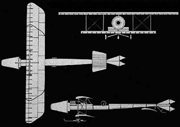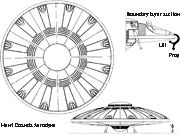E-Archive
Off the Beaten Track
in Vol. 12 - July Issue - Year 2011
The Coanda Effect

Coanda-1910 - First jet aircraft of the world

Modern aircraft using the Coanda effect

The Aerodina Lenticulara
A loud thump accompanied each blow of the rubber stamp on the papers piled in front of the office clerk. He had been mechanically repeating the same gestures for the past twenty-seven years and he was way past the stage of being bored with his job. In fact, he managed to survive his workdays only by planning what to do over the next weekend and by keeping a keen eye on the large, round clock hanging on the far wall of his dusty and silent office. A few more minutes and he would finally be enjoying the fresh air outdoors. He cast a distracted glance at the drawing which he had almost completely obliterated with his stamps: a “Turbine Aeroplane” powered by something called an “Air-Reaction Engine”, whatever that was supposed to mean. The clerk had heard that somebody had actually invented a flying machine, but after so many years of archiving patent applications, he had developed a strong skepticism for any invention which he couldn’t immediately understand, and this was one of them. It was probably destined to oblivion, like so many other crazy ideas he had seen before…
*****
In 1910 a Rumanian aeronautical engineer named Henri Coanda filed a patent for what he described as the world’s first jet airplane, known as the Coanda-1910. It was powered by a water-cooled 50 hp four-cylinder engine which transmitted energy to a compressor through a gearbox. The compressed air went to combustion chambers located along the sides of the fuselage where it was mixed with fuel and ignited, thus creating sufficient thrust to propel the aircraft through the skies. Or at least, this is what Coanda claimed, because the aircraft was destroyed before anybody could actually see it in flight. According to his account, while Coanda was tinkering with the engine as it warmed up, the aircraft suddenly started to roll forward and Coanda was forced to jump into the pilot’s seat in a vain attempt to bring the plane under control. Notwithstanding his efforts, the aircraft lifted off the ground and Coanda, who was not a pilot, was almost killed when the plane crashed to the ground a few moments later. He had no funds to build a second aircraft and so his project was abandoned.
However, while developing his invention, Coanda had observed that the blast of flames and hot air which came out of the combustion chambers behaved strangely. Contrary to what would have been expected, Coanda noticed that this hot air did not travel in a straight line along the fuselage of the aircraft, but rather that it followed the convex curvature of the fuselage. This phenomenon led him to conclude that when a fluid moves at high speed near a convex curved surface, it adheres to that surface. This proved to be true for both liquids and air, although the flow speed for air had to be much higher. This became known as the “Coanda effect” and the Rumanian inventor soon verified that this effect could be used to generate lift in aircraft.
Development of the jet engine applied to aircraft gained speed in the 1930’s, mostly due to the mounting military build-up in those years. Although he went on to design various traditional types of aircraft, Coanda was convinced that it would be necessary to come up with something radically different if significant improvement in performance were to be achieved.
In 1938 he patented a rather unusual disc-shaped aircraft which he called “Aerodina Lenticulara” and which exploited the Coanda effect by directing the blast of air from a jet engine over the edge of the disc, thus providing lift and propulsion. His design was further advanced in some countries before, during and after the Second World War. Research in this field accelerated tremendously during the Cold War, always in great secrecy, as both sides sought to develop an aircraft which would give them a decisive edge over their adversaries. Coanda continued filing new patents for disc aircraft well into the 1960’s, although the basic design of his first model remained unchanged. Looks familiar, doesn’t it?
By Giovanni Gregorat, Contributing Editor MFN & Sales Manager, Pometon Abrasives
Author: Giovanni Gregorat



























